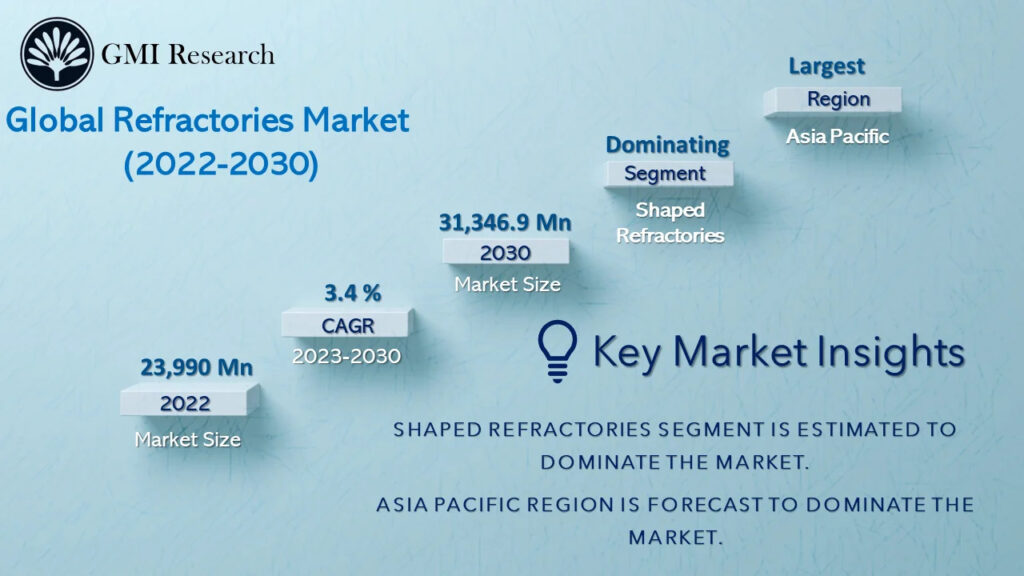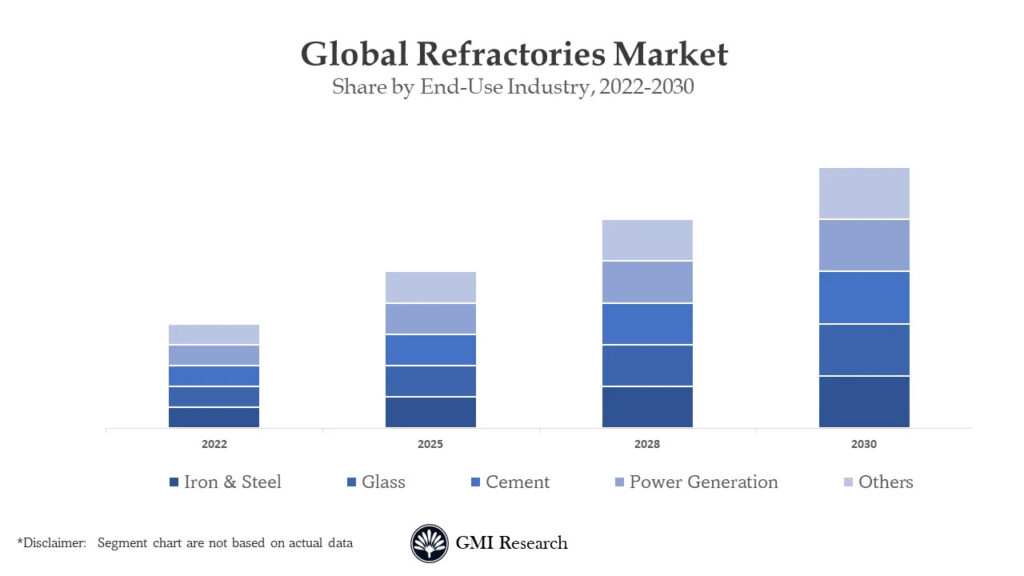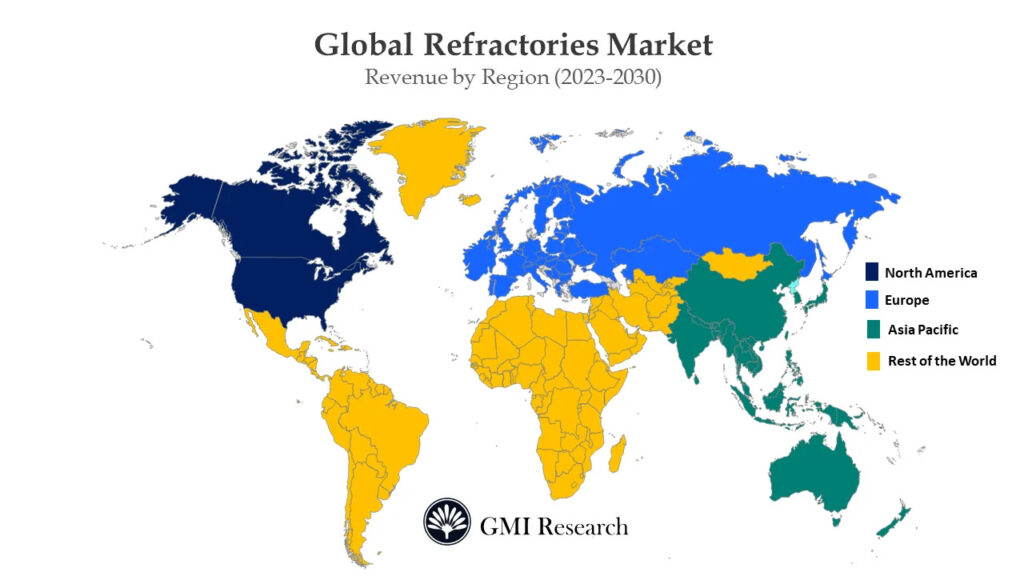Refractories, ceramic materials engineered to endure extremely high temperatures exceeding 1,000 °F, surpass metals in heat resistance. They are used to line surfaces within different industrial procedures. Apart from enduring thermal stress and heat-induced physical phenomena, refractories can resist physical wear and corrosion resulting from exposure to chemical agents. Therefore, refractories are important in the manufacturing of petrochemical products and the refining of gasoline, confirming the integrity of equipment in high-temperature industrial procedures.
Refractory products typically belong to either preformed shapes or unformed compositions, commonly known as specialty or monolithic refractories. Then, refractory ceramic fibers, resembling residential insulation, deliver insulation at significantly higher temperatures than conventional insulating materials.
Traditionally, bricks and shapes have been the primary form of refractories, historically representing most of the refractory production. Refractories are versatile and available in different shapes and sizes. They can be pressed, molded for floors and walls, crafted into interlocking shapes and wedges, or curved to fit inside boilers and ladles.
You may like: What is NLP
Market Size

Refractories market size and growth were valued at USD 23,990 million in 2022 and are anticipated to observe a CAGR of 3.4% in the forecast period due to increasing requirements for non-ferrous metals, continuous developments in refractory technologies, and significant growth in applications of refractories in different end-user industries.
Types of Refractories
Refractory bricks are accessible in a broad variety of shapes and sizes personalized to precise industry requirements. Some common examples of refractory materials include the following:
- Silica Refractory: Silica brick, with nearly 93% SiO2, is an essential refractory material. Top refractory cement suppliers in India use high-quality rocks as raw materials for their production. Silica bricks are renowned for their exceptional mechanical strength, specifically as temperatures approach their actual melting point. These distinctive characteristics set silica refractories apart from other materials involving alumino-silicate refractories. Refractories other than silica bricks tend to start fusing and creeping at temperatures lower than their actual fusion points. Different types of silica bricks are used in industries such as steel and glass owing to their high resistance to these effects.
Fireclay Refractory: Hydrated aluminum silicates containing nearly 25%–45% AI203 and 50%–80% SiO2 are denoted as fireclay refractories. These materials typically contain minimal additional minerals. Fireclay refractories are prevalent and cost-effective, as their raw ingredients are readily accessible. They are broadly used in furnaces, regenerators, stoves, kilns, and many other applications owing to their versatility and accessibility.
- Magnesite Refractory: Magnesite refractories, composed of nearly 85% magnesium oxide, are considered chemically fundamental materials. Made from magnesite (MgCO3) and silica, these refractories may have weaker attributes, but their primary value lies in their resistance to basic slags, specifically those comprising lime and iron-rich components. Magnesite refractories are important in the basic steel manufacturing procedures. Basic bricks made of magnesite find applications in different places, including:
- Lime and cement kilns
- Glass tank checks
- Metallurgical furnaces, and
- Metallurgical burners.
- Zirconia Refractories: Zirconia refractories exhibit exceptional hardness at room temperature, and this hardness can be maintained around different applications, even within the temperature range of up to 1500 degrees Celsius. Zirconia refractories have significantly lower thermal conductivity compared to other types of refractory materials. In addition, these refractories do not react with molten glass or any other liquid metals. Therefore, these are perfect for use in high-temperature construction materials for glass and metallurgical furnaces due to their non-reactive nature and excellent thermal properties.
Driver: Growth in the Development of Infrastructures Around Emerging Nations

The fastest growth in urbanization and industrialization, surprisingly in developing nations such as China and India, has led to noteworthy investments in the building of private and public infrastructure. According to the Worldwide Development Viewpoint and Oxford Economies, the global construction market is expected to grow by 85% to USD 15.55 trillion globally by 2030. India, China, and the US are predicted to register for 57% of this global growth.
China, as one of the fastest-developing nations, faces growing travel requirements, necessitating continuous developments in its rail routes and roadway infrastructure. The accelerated infrastructural development in speedily increasing nations, including China, has also fostered the automotive industry in the country. This increased pace of infrastructure growth has led to an expansion in different segments.
The growing demand for refractories in the steel and iron as well as cement industries is a natural outcome of increased infrastructure development, propelled by increasing regions. In addition, the enlarging construction activities in these regions are predicted to foster the glass industry, subsequently propelling the demand for refractories.
You may like: Artificial Intelligence in Healthcare Sector
Challenges in the Refractories Market
The refractories market heavily depends on the steel and iron industry, accounting for over 60% of the global market. The remaining 40% is covered by end-use industries that include cement, glass, power generation, petrochemicals, paper and pulp, non-ferrous metals, and chemicals.
Thus, any decline in the iron and steel industry would lead to a subsequent decline in the refractories market. The demand for refractory materials or products from the steel and iron sectors has been unpredictable in the present years, significantly impacting the entire market.
Asia Pacific Registered the Market Growth
The Asia-Pacific region emerged as the largest customer of refractory products. The substantial demand for refractories in industries such as power generation, glass, cement, petrochemicals, non-ferrous metals, chemicals, and others is attributed to this significant demand in the Asia-Pacific region.




